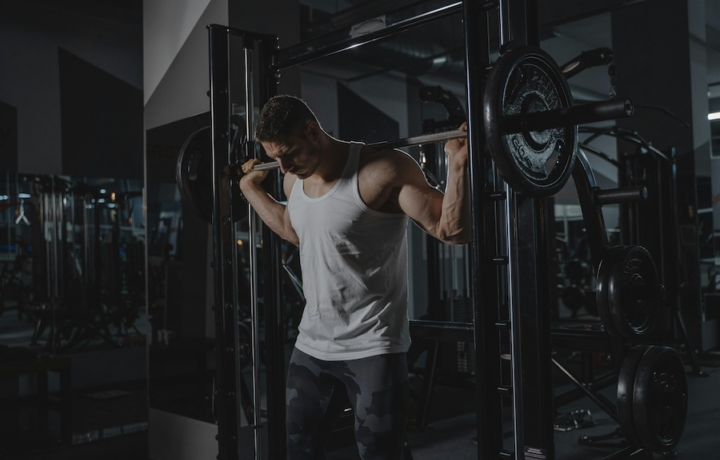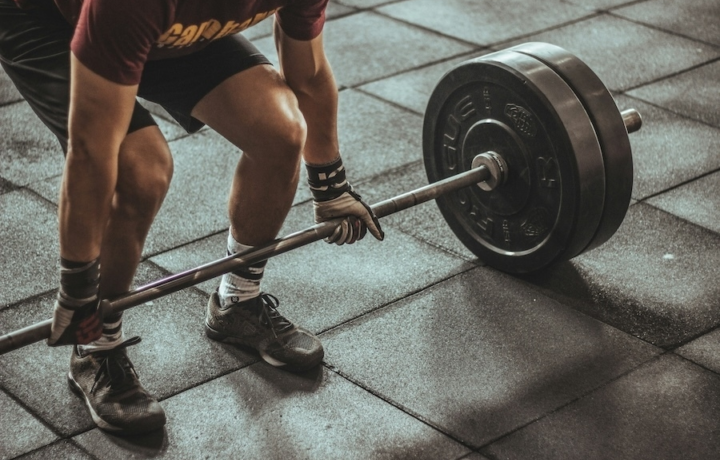Exercise
Dumbbell Deadlift

Dumbbell Deadlift
How to Perform
- Stand with your feet shoulder-width apart, toes pointed forward, with a dumbbell positioned on the outside of each foot.
- Hinge at the hips and bend your knees slightly, maintaining a neutral spine while reaching down to grasp the dumbbells with palms facing your body.
- Grip the dumbbells firmly with your shoulders pulled back and down, ensuring your chest is up and core is braced before initiating the movement.
- Take a deep breath in and hold it to create intra-abdominal pressure, then drive through your heels while keeping the dumbbells close to your shins.
- Push your hips forward as you stand up tall, keeping your arms straight and the dumbbells close to your body throughout the entire movement.
- At the top position, stand tall with shoulders back, glutes squeezed, and knees fully extended but not locked.
- Exhale at the top, then initiate the descent by hinging at the hips first, pushing your buttocks backward while maintaining a flat back.
- Lower the dumbbells with control until they touch the floor, keeping your chest up and spine neutral throughout the descent.
Important information
- Keep your back flat throughout the entire movement—never round your spine as this can lead to injury.
- Focus on pushing the floor away rather than lifting with your back; the power should come from your legs and hips.
- Select a weight that allows you to maintain proper form through all repetitions; start lighter if you're new to deadlifts.
- Position the dumbbells slightly in front of your ankles at setup, not directly under them, for optimal leverage.

Dumbbell Deadlift
Exercise Details
Primary Muscles
Muscle Groups
Mechanic
Risk Areas
Built for progress
Take the guesswork out of training
Create personalized AI-powered workout plans that evolve with you. Train smarter, track every rep and keep moving forward, one workout at a time.






The dumbbell deadlift stands as a cornerstone movement for developing lower body strength and power while offering more accessibility than its barbell counterpart. This intermediate exercise primarily targets the glutes, hamstrings, and erector spinae, making it exceptional for both bodybuilding enthusiasts looking to sculpt their posterior chain and powerlifters seeking to enhance their overall pulling strength.
What makes the dumbbell deadlift particularly valuable is its versatility and reduced technical demands compared to conventional deadlifts. The dumbbells naturally position your grip at your sides rather than in front of your body, creating a more intuitive pulling pattern that many find comfortable for their anatomical structure. This adjustment can significantly reduce stress on the lower back while still effectively engaging the target muscle groups.
For strength development, the dumbbell deadlift delivers impressive results despite typically using less total weight than barbell variations. The independent nature of dumbbells introduces an element of stabilization that increases neuromuscular demands, potentially leading to greater overall strength gains when programmed correctly. Many serious lifters incorporate this movement as an accessory to complement their heavier conventional deadlifts or as a primary movement during deload phases.
The exercise seamlessly bridges the gap between functional fitness and aesthetic development. From a bodybuilding perspective, the dumbbell deadlift creates tremendous tension through the hamstrings and glutes, stimulating muscle growth in areas that contribute significantly to a balanced physique. The constant tension maintained throughout the movement, particularly at the top position, makes it excellent for developing the dense, powerful look sought by physique athletes.
Whether your goals lean toward raw strength development or muscular hypertrophy, the dumbbell deadlift deserves a place in your training regimen. Its joint-friendly nature makes it sustainable for long-term progression while still delivering the hormonal response and muscle recruitment patterns that drive results. Consider implementing this exercise twice weekly within your program for optimal development of your posterior chain.
FAQ - Dumbbell Deadlift
The dumbbell deadlift primarily targets your posterior chain, with major emphasis on the glutes, hamstrings, and erector spinae (lower back). It also engages your quadriceps, core, trapezius, and forearm muscles as stabilizers throughout the movement.
Dumbbell deadlifts position your grip naturally at your sides rather than in front of your body, creating a more intuitive pulling pattern that many find less stressful on the lower back. This variation typically requires less total weight while introducing greater stabilization demands, making it more accessible for beginners while still challenging for advanced lifters.
The most common mistakes include rounding the lower back, lifting with the arms instead of pushing through the legs, allowing knees to cave inward, and failing to maintain a neutral spine. Always start with the dumbbells positioned alongside your feet, hinge at the hips while keeping your chest up, and drive through your heels while maintaining a flat back.
For optimal development, incorporate dumbbell deadlifts 1-2 times weekly with at least 48 hours between sessions to allow for proper recovery. If you're also performing conventional deadlifts, consider using dumbbell deadlifts as an accessory movement on a separate day or during deload phases to reduce cumulative fatigue while maintaining training stimulus.
Progress by gradually increasing weight once you can complete your target reps with perfect form. You can also implement advanced techniques like tempo work (slow eccentric phase), paused reps at the bottom position, or higher volume approaches (12-15 reps) to continue challenging your muscles without necessarily requiring heavier dumbbells.









